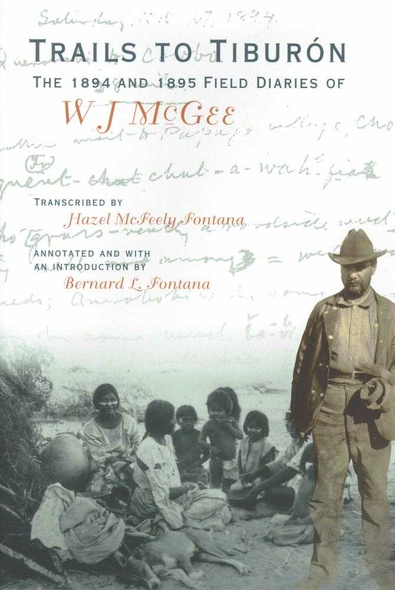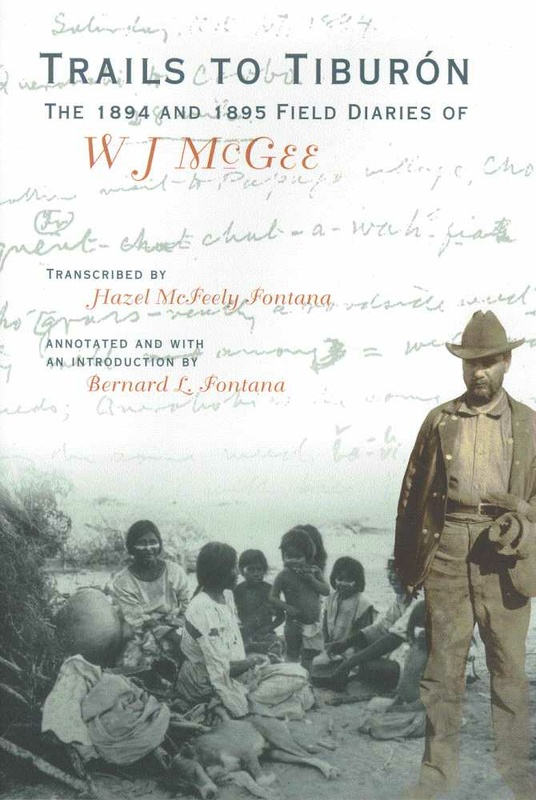Trails to Tiburón
The 1894 and 1895 Field Diaries of W J McGee
SERIES:
The University of Arizona Press
When William John McGee set out from Washington, D.C., for the Sonoran Desert in 1894, he was inspired by a passion for adventure as much as a thirst for knowledge. McGee lived in an era when discovery was made through travel rather than study, and reputations were forged by going where no outsiders had gone before.
A self-taught scientist in the newly forming field of anthropology, McGee led two expeditions through southern Arizona and northern Sonora for the Bureau of American Ethnology. There he conducted ethnographic research among the Papagos (Tohono O'odham) and the Seris, and his subsequent publication The Seri Indians helped secure his place in the anthropological community.
McGee's complete journals of the expeditions, kept in small field notebooks and preserved in the Library of Congress, are published here for the first time. These journals contain detailed descriptions of the country and people McGee encountered and convey the adventure of traveling through wild and unfamiliar places—including a voyage to Isla Tiburón, or Shark Island, in the Gulf of California—and being plagued by foul weather, a shortage of supplies, and fear of attack from hostile Indians.
Trails to Tiburón features 57 historical photographs taken on the expedition, capturing the places McGee saw and the people he encountered. Fontana's notes to the diary provide useful botanical, geological, and ethnographic information, while his introduction places McGee and his field work in the context of late-nineteenth-century anthropology and science.
Trails to Tiburón reveals McGee's versatility as a field worker and shows his methods, often questioned today, to be the reasonable response of a man caught up in the intellectual fervor of his time. For anyone wanting to share in the spirit of adventure, these journals are a landmark in the annals of exploration.
A self-taught scientist in the newly forming field of anthropology, McGee led two expeditions through southern Arizona and northern Sonora for the Bureau of American Ethnology. There he conducted ethnographic research among the Papagos (Tohono O'odham) and the Seris, and his subsequent publication The Seri Indians helped secure his place in the anthropological community.
McGee's complete journals of the expeditions, kept in small field notebooks and preserved in the Library of Congress, are published here for the first time. These journals contain detailed descriptions of the country and people McGee encountered and convey the adventure of traveling through wild and unfamiliar places—including a voyage to Isla Tiburón, or Shark Island, in the Gulf of California—and being plagued by foul weather, a shortage of supplies, and fear of attack from hostile Indians.
Trails to Tiburón features 57 historical photographs taken on the expedition, capturing the places McGee saw and the people he encountered. Fontana's notes to the diary provide useful botanical, geological, and ethnographic information, while his introduction places McGee and his field work in the context of late-nineteenth-century anthropology and science.
Trails to Tiburón reveals McGee's versatility as a field worker and shows his methods, often questioned today, to be the reasonable response of a man caught up in the intellectual fervor of his time. For anyone wanting to share in the spirit of adventure, these journals are a landmark in the annals of exploration.
An exceptionally informative view of an early piece of amateur ethnography . . . beautifully published.'—Journal of Anthropological Research
'While McGee's fieldwork and attitudes may leave us perplexed today, his exploits are well introduced here by excellent and extensive annotations. . . . This book is not just a light reflection on the past. Instead the Fontanas have transformed simple field diaries into a reference piece on nineteenth-century ethnography and provided an excellent regional work on the historic Arizona-Sonora border region.'—American Indian Quarterly
'This book is not just for readers of ethnography. It cuts across ruts of interest, like the best finely tuned essays we find in New Yorker. From our own parochial paths, we may start reading in complete disinterest and ignorance, but by story's end we realize something special has been added to our world. It is a visit to a new country, a first meal at a fine restaurant or, for some who already know McGee and Sonora, a visit with old, old friends.'—Folio
Bernard and Hazel Fontana have collaborated on several publications since their marriage in 1954. Hazel's art has illustrated such books as Edward Spicer's Cycles of Conquest and Herbert R. Hislop's An Englishman's Arizona. Now retired, Bernard Fontana was formerly ethnologist at the Arizona State Museum and field historian at the University of Arizona Library. Among his many books are Of Earth and Little Rain: The Papago Indians and Tarahumara: Where Night Is the Day of the Moon, both with photographs by John P. Schaefer.






